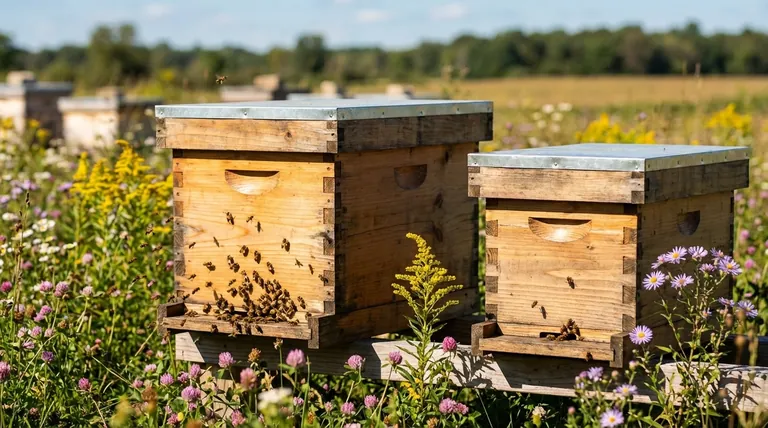The size of a nucleus colony directly dictates its foraging pressure on the local environment. A larger nuc, with a greater population of forager bees, will naturally gather more nectar and pollen. This increases the competition for these finite resources, affecting not only itself but all other hives in the vicinity.
The core principle is a simple balance of scale: while a large nuc is a powerful foraging unit, its strength can inadvertently create a resource deficit in a crowded area. Managing nuc size is therefore a critical strategy for ensuring the sustainable health of an entire apiary.

The Mechanics of Foraging Competition
A bee colony operates as a single superorganism, and its ability to gather resources is a direct function of its population. Understanding how this scales up is key to managing your hives effectively.
The Forager Workforce
As a nuc grows, so does its absolute number of forager bees. A larger population can deploy a significantly larger workforce to collect resources at any given time.
This means more bees are simultaneously visiting flowers and depleting the available nectar and pollen within the hive's flight range.
The Impact on Resource Density
A strong, large colony can quickly diminish the resources in its immediate vicinity. This forces bees from all nearby hives, including their own, to fly farther to find adequate food.
Longer foraging trips are less efficient and place greater stress on the bees, reducing their lifespan and the colony's overall net energy gain.
The Apiary-Level Effect
The impact of a single nuc's size is magnified when considered in the context of an entire beeyard, where multiple colonies share the same environment.
Competition in Crowded Beeyards
In a large apiary with many hives, the collective foraging pressure can be immense. If most of those hives are large, they create intense competition among themselves.
Using smaller nucs in this scenario can help moderate the overall demand, reducing stress and ensuring more equitable access to food for all colonies.
Overall Apiary Health
When food becomes scarce due to over-competition, the health of the entire apiary can suffer. Colonies may experience slower brood production, reduced honey stores, and increased susceptibility to disease.
By managing the size of your colonies relative to the available forage, you are not just managing individual hives, but the health of the local ecosystem.
Understanding the Trade-offs
Choosing a nuc size is not about simply minimizing competition; it's about matching the colony's strength to its environment and your specific goals.
The Strength of a Large Nuc
A large nuc builds up faster, defends itself more effectively against pests and predators, and can capitalize on strong nectar flows to produce a surplus of honey. In an environment rich with forage, a large colony is a significant asset.
The Vulnerability of a Small Nuc
Conversely, a very small nuc is more vulnerable. It can struggle to thermoregulate, defend the hive, and may not have the workforce to gather enough resources to grow, especially in a competitive environment or during a nectar dearth.
Making the Right Choice for Your Goal
The optimal nuc size is entirely dependent on your objectives and the carrying capacity of your location.
- If your primary focus is maximizing honey production in a resource-rich area: A larger nuc is advantageous, as its powerful foraging force can quickly capitalize on abundant nectar.
- If your primary focus is managing a high-density apiary with limited forage: Using smaller nucs helps reduce overall competition, preventing resource depletion and promoting better health across all colonies.
- If your primary focus is raising queens or making splits: Starting with smaller nucs is the standard, as it provides a controlled environment for the new queen to establish herself without excessive resource pressure.
Ultimately, successful beekeeping lies in balancing the ambition of an individual colony with the carrying capacity of its environment.
Summary Table:
| Nuc Size | Foraging Impact | Best Use Case |
|---|---|---|
| Large Nuc | High competition; depletes local resources quickly | Maximizing honey production in resource-rich areas |
| Small Nuc | Lowers overall competition; reduces resource stress | High-density apiaries, raising queens, or making splits |
Optimize your apiary's health and productivity with the right equipment from HONESTBEE. Whether you're a commercial apiary or a distributor managing high-density beeyards, our wholesale-focused supplies are designed to support your specific goals. Let us help you build a more sustainable and profitable operation. Contact our experts today to discuss your needs!
Visual Guide

Related Products
- 5 Frame Wooden Nuc Box for Beekeeping
- Automatic Heat Preservation 6 Frame Pro Nuc Box for Honey Bee Queen Mating
- Twin Queen Styrofoam Honey Bee Nucs Mating and Breeding Box
- Styrofoam Mini Mating Nuc Box with Frames Feeder Styrofoam Bee Hives 3 Frame Nuc Box
- Portable Bee Mating Hive Boxes Mini Mating Nucs 8 Frames for Queen Rearing
People Also Ask
- What is the purpose of having a nuc in beekeeping? Build a Resilient & Productive Apiary
- What frames should be moved into the queenless hive when requeening with a nuc? Ensure a Successful Queen Introduction
- How should the nuc be installed in the apiary? Ensure Colony Success from Day One
- What is a common feature of many 5-frame nuc boxes? The Integrated Feeder for Efficient Colony Growth
- What are the benefits of using nucs for beginning beekeepers? Ensure a Successful First Hive with a Head Start



















